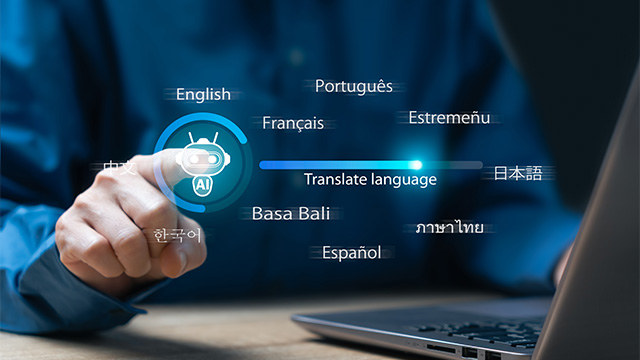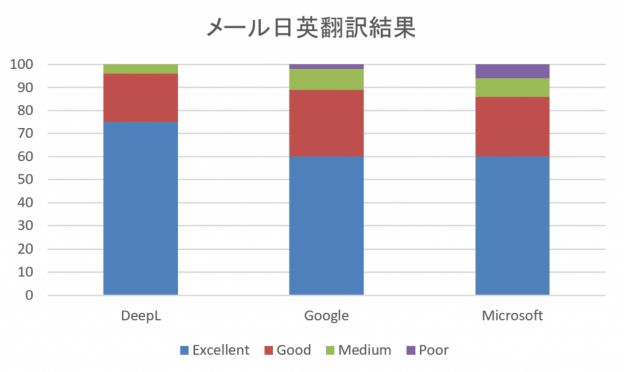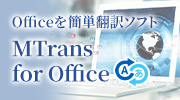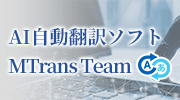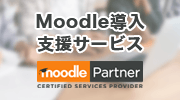
In recent years, as the accuracy and prevalence of machine translation have improved, you may have heard the term "post-editing" more frequently. While the number of companies and individuals using machine translation tools is increasing, there are cases where machine translation alone does not provide sufficient translation quality. This is where "post-editing" plays a crucial role in enhancing translation accuracy. Post-editing is the process of correcting and adjusting the output of machine translation, and it is an essential task, especially for documents that require precision, such as legal documents, technical documents, and marketing materials. This article will focus on four important points of post-editing and introduce methods to make the use of machine translation even more effective.
- Table of Contents
-
- 1. What is post-edit?
- 2. Reasons for needing post-editing
- 3. Types of Post-Editing
- 4. Skills Required for Post-Editing
- 5. Comparison Sample of Full Edit and Light Edit
- 6. Benefits of Post-Editing
- 7. Post-Editing Procedure
- 7-1. Pre-edit
- 7-2. Machine Translation
- 7-3. Post-edit
- 7-4. Check by Proofreader and Reviewer
- 8. Four Points to Keep in Mind During Post-Editing!
- 8-1. Numerical Values
- 8-2. Tags
- 8-3. Inconsistency in Style and Expressions
- 8-4. Terminology
- 9. Summary
1. What is post-edit?
"Post-editing" refers to the process of reviewing translations generated by machine translation and making corrections as necessary. A specialist who performs this task is called a "post-editor."
In traditional translation work, it was common for the translator to translate the original text, and for a reviewer to check that translation. On the other hand, when using machine translation, the translation itself is done by the machine, and a post-editor compares the original text and the translated text to make corrections and adjustments. This allows for part of the translation process to be automated, making it possible to proceed efficiently while reducing the overall work time.
2. Reasons for needing post-editing
Although the accuracy of machine translation has been improving year by year, it is still difficult to expect the same level of accuracy as human translators. Therefore, post-editing plays an important role. There are several reasons why post-editing is necessary.
Context Understanding:
While machine translation has a high ability to accurately translate words and phrases, it can be difficult to deeply understand and translate context. This is especially true for documents that contain ambiguous expressions, technical terms, or cultural nuances, which are prone to mistranslations or unnatural translations. Post-editing allows for adjustments that take these contexts into account.
Consistency and Uniformity:
In long documents and complex content, it is important to maintain consistency in terminology and expressions. Machine translation can sometimes output the same term with different translations, which can affect the overall reliability of the document. Post-editors check for consistency in terminology and style, providing a unified, high-quality translation.
Grammar and Style:
Machine translation output may not be grammatically correct or may not read naturally. It is especially necessary to adjust the text to be more fluent according to the grammatical rules and style of the target language. Post-editing is the necessary work to make the text understandable and polished for the reader.
Accuracy in Specialized Fields:
In translations that require specialized knowledge, such as technical documents and legal documents, it can be difficult for machine translation to accurately capture specialized terminology and specific contexts. Post-editors possess expertise in the field and make corrections to ensure accurate translations.
3. Types of Post-Editing
There are two types of post-editing: full editing and light editing.
Full editing produces translations of quality equivalent to, or nearly indistinguishable from, those done by humans. The work involves thoroughly correcting errors in meaning, omissions, unnatural expressions, and grammatical mistakes, as well as fully unifying style (tone & manner), terminology, and notation (e.g., presence or absence of long vowel marks) according to specified guidelines and context. Additionally, the text must be fluent and natural enough that readers do not realize it was machine-translated.
On the other hand, light editing aims to ensure that the main meaning of the translated text is understandable and free of critical errors. The work involves correcting major mistranslations or omissions that distort the meaning, as well as grammatical mistakes that hinder comprehension. However, slightly unnatural expressions or awkwardness are generally left as is, as long as the meaning is clear. In addition, inconsistencies in terminology or notation are not corrected if they do not interfere with understanding. The scope of corrections must be agreed upon with the client before the project begins. For example, if plain and polite forms are mixed, it should be decided in advance whether this is acceptable as long as the meaning is correct, or if the text should be unified into the polite form.
Which method to choose depends on the project's purpose, budget, and deadline. For example, full editing is recommended when accuracy and quality are important, such as for marketing materials or official documents. On the other hand, light editing may be suitable for internal documents or when the goal is quick information sharing over a short period. The final choice is made based on the project's requirements.
4. Skills Required for Post-Editing
Both full editing and light editing require understanding the subject matter expertise and cultural background, as well as a deep comprehension of the meaning of the original and translated texts.
Additionally, in the case of full editing, post-editors are required to have advanced translation skills and editing abilities. It is essential to have the language proficiency to accurately compare the source and target texts and make perfect corrections in grammar, syntax, and vocabulary choice. Attention to detail and patience are also necessary to ensure text consistency, readability, and compliance with style guidelines. Furthermore, sensitivity to appropriately reflect the nuances and style of the original text, as well as editorial judgment that always considers the target audience, are required.
When performing light editing, it is important for post-editors to have efficient work skills and the ability to prioritize. They must be able to identify critical errors within a limited time and exercise judgment to produce readable text with minimal corrections. Practicality is valued over perfection, and the decision to deliberately leave unnatural expressions as long as the meaning is conveyed is also necessary. Additionally, understanding the characteristics and weaknesses of machine translation and analyzing which parts should be most effectively corrected is crucial. Post-editors must have a sense of balance to avoid excessive editing while ensuring that errors that hinder basic comprehension of the text are reliably fixed.
5. Comparison Sample of Full Edit and Light Edit
Original Text:
Collecting user feedback is a crucial step for product development. The development team analyzes every user comment thoroughly. This continuous process ensures the product meets market needs.
Unedited Machine Translation:
Collecting user feedback is an important step in product development. The development team thoroughly analyzes all user comments. This ongoing process ensures that the product meets market needs.
Light Edit:
Collecting user feedback is an important step in product development. The development team thoroughly analyzes all user comments. This ongoing process ensures that the product meets market needs.
Full Edit:
Collecting user feedback is an important step in product development. The development team thoroughly analyzes all user comments. By continuing this process, it becomes possible to align the product with market needs.
Description:
In the unedited machine translation, plain and polite forms were mixed. The light edit unifies the text into polite form. The full edit not only unifies the text into polite form but also standardizes the inconsistent long vowel endings in katakana ("ユーザー" and "ユーザ") to the long vowel form ("ユーザー"). Additionally, the final sentence has been completely rewritten to achieve a more natural English expression.
6. Benefits of Post-Editing
By performing post-editing, you can enjoy the following benefits.
Reduction of man-hours:
Translation work is performed by machines, which can shorten the time compared to traditional translation processes. With proper work by post-editors, translation can be completed in a short time.
>How to streamline post-editing after machine translation?
Translation Quality Improvement:
Machine translation alone can result in unnatural expressions and mistranslations, but by performing post-editing, these issues can be resolved, leading to more natural and accurate translations. In particular, for specialized content or context-dependent parts, post-editing contributes to quality improvement.
7. Post-Editing Procedure
This section explains the procedure for full-edit post-editing work. The goal is to produce a natural translation that the reader does not perceive as machine-translated. This process is broadly composed of four stages.
7-1. Pre-edit
The first step is "pre-editing" before applying machine translation. This process involves adjusting the source text in advance so that the machine translation engine can better understand the original text and produce higher-quality translations. Specifically, it includes clarifying the referents of pronouns, disambiguating ambiguous expressions by making them more specific, and splitting or simplifying overly long or complex sentences. It also involves correcting typos and grammatical errors in the source text, and importantly, standardizing terminology, especially technical terms and proper nouns, beforehand. Additionally, formatting adjustments such as organizing unnecessary line breaks and special characters are included. Improving the quality of the source text through this pre-editing significantly contributes to enhancing the accuracy of subsequent machine translation and streamlining the post-editing process.
7-2. Machine Translation
Next, the pre-edited source text is input into the selected machine translation engine to perform machine translation into the target language. Here, by leveraging the features provided by the machine translation service, the quality of the translated text is improved. For example, applying glossaries and past translation assets (translation memories) enhances the consistency of the translation and the accuracy of specific terminology. Additionally, if possible, using automatic post-editing functions can reduce the workload of subsequent post-editing tasks. For more details on automatic post-editing, please refer to the blog article below.
>How to streamline post-editing after machine translation?
7-3. Post-edit
Post-editing is a core process in this workflow. Post-editors with specialized skills (often translators) review the machine-translated draft and revise and improve it to a quality level equivalent to human translation.
The most important thing is to deeply understand the content of the original text. The post-editor carefully reads the original text to accurately grasp the context, the author's intent, nuances, and the intended audience. This understanding of the original text is an essential step because if one starts correcting by only looking at the machine translation output without sufficient comprehension, there is a risk of making superficial corrections or producing a translation that deviates from the original intent.
Next, we rigorously verify that the translation accurately reflects the meaning and information of the original text. We carefully compare the source and translated texts to check for mistranslations, omissions of information from the original, or any added information not present in the source. We also validate the accuracy of proper nouns and data such as personal names, place names, organization names, dates, numbers, units, and technical terms.
Then, based on the review results, we specifically correct and revise the parts judged to be incorrect. This includes fixing mistranslations and omissions, correcting grammatical errors in the target language (such as tense, number, case, particles), and unifying terminology according to the specified glossary and style guidelines. We also adjust punctuation, symbols, and the use of uppercase and lowercase letters in accordance with the rules.
Finally, we go beyond merely correcting accuracy and review the unnaturalness of the translation to improve it into a more natural and fluent expression. We eliminate the awkwardness unique to machine translation (so-called "translationese") and produce text that reads naturally to the target language audience. We select the vocabulary most appropriate to the context, refine phrasing, and improve the connections between sentences to create a logical flow. Additionally, we appropriately reflect the tone and manner of the original text (whether formal or informal, objective or subjective) in the translation, and check for any inappropriate or hard-to-understand expressions considering cultural background. In a full edit, if necessary, we may make substantial changes to sentence structure while preserving the original meaning.
7-4. Check by Proofreaders and Reviewers
After post-editing is completed, a final quality assurance check is conducted by a different person than the post-editor (such as a proofreader, checker, reviewer, or subject matter expert). By incorporating a third-party perspective, errors that the post-editor may have overlooked—such as typos, grammatical mistakes, inconsistencies in notation, and punctuation errors—are identified and corrected. Additionally, a final verification is performed to ensure consistency of terminology and expressions throughout the document, and that the style guide and project instructions have been fully adhered to. If necessary, the text may be cross-checked against the original to re-verify the accuracy of the meaning. After this proofreading and review process, any corrections are applied, completing the translated deliverable.
8. Four Points to Keep in Mind During Post-Editing!
As mentioned earlier, the latest machine translation technologies have several weak points. Here are four points to keep in mind during post-editing.
8-1. Numerical Values

This is the result translated by an online translation tool.
We will not examine the accuracy of the English text in detail, but please pay attention to the numbers underlined in red. Numbers different from the original text have been applied in the translation.
The latest machine translation technology can generate very fluent translations, but occasionally such numerical errors occur.
The above example is an extreme case, but you would want to avoid sending a quotation to a customer with such a translation. Be sure to include a post-editing step to eliminate any numerical errors.
8-2. Tags
When translating tagged files such as HTML or XML, special attention must be paid to the "tags."
Tags include formatting tags that modify text and variable tags that change displayed content depending on the context. When translating sentences containing these, necessary tags may be accidentally omitted from the translation or, conversely, added unnecessarily. Therefore, during post-editing, the tag structures of the source and translated texts are compared and, if needed, correctly rearranged.
Also, when a sentence contains many tags, the accuracy of machine translation itself can significantly decrease. Such translations often require retranslation, so post-editing is essential when machine translating tagged files like HTML or XML.
8-3. Inconsistency in Style and Expressions
When translating, it is important to unify expressions and styles to avoid confusing the reader.
Looking at the example above, the English sentence structure is the same, but the Japanese structure differs.
Also, common inconsistencies such as "サーバ" and "サーバー", or "ユーザ" and "ユーザー" often occur.
While such unification is not always necessary in general documents, it is considerate to the reader to standardize expressions when translating manuals or procedural documents. This is also a point to correct during post-editing.
8-4. Terminology
Finally, it is important to pay attention to "terminology."
The red underlined parts above should refer to the same guide, but in the translated text (English), different terms are used. Such "terminology inconsistency" can cause inconsistencies within the content, which may result in a decline in brand strength. Make sure to properly standardize terminology during post-editing.
These are the four key points to keep in mind at a minimum during post-editing.
By making adjustments to these points as needed before sending emails to clients or publishing content, you can improve the accuracy of the translation, so please give it a try.
9. Summary
At Human Science, we offer post-editing services. In addition to having extensive knowledge and experience in post-editing, Human Science selects post-editors with specialized expertise who can correct not only linguistic mistranslations but also terminology errors, thereby enhancing the quality of machine translation outputs. We have many post-editors who have conducted translation reviews in specialized fields such as "Manufacturing (automotive, machine tools, control equipment, robotics, FA equipment, etc.)", "IT", and "Pharmaceuticals and Medical".
>Human Science | Post-Editing Agency Service
We also offer "MTrans for Trados," a convenient tool for companies that wish to perform post-editing in-house. MTrans for Trados is a machine translation solution developed by our company for corporate clients. By simply installing the plugin, you can utilize machine translation from Google, DeepL, Microsoft, and OpenAI. There is no need to contract with each machine translation service provider. Additionally, it includes features necessary for industrial translation, such as automatic application of terminology and style rules, significantly reducing the workload of post-editing. You can also take advantage of the flat-rate invoicing option that is highly requested by our corporate clients.
Related Services
> Neural Machine Translation Integration Solution MTrans for Trados










